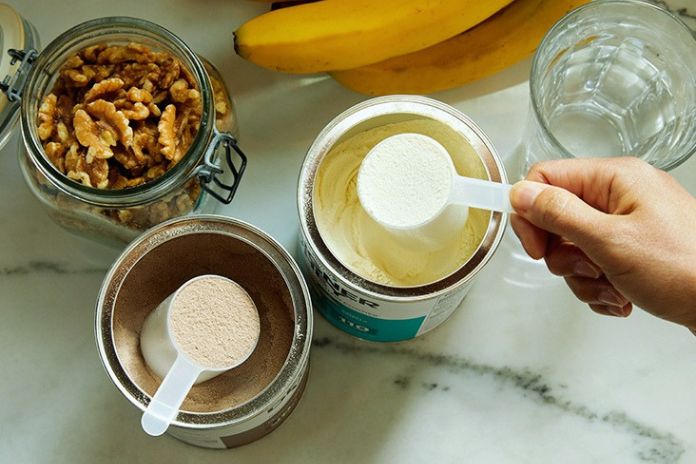Nutrient-rich foods are often also high in calories. Below is a list of 10 typical diet foods that sabotage your slimming plans.
Green Juice
So it is! To soften the strong flavor of vegetables, green juices can contain high amounts of sugar, in some cases almost as much as soda. We suggest adding a little stevia or brown sugar to your green juice.
Gluten-Free Snacks
Going gluten-free is something you do when you have celiac disease. Many people have avoided gluten to lose weight, which could be considered a good strategy until the food industry launched a series of products such as cookies, toast, and even pizza without gluten, but with a lot of sugar and fat. Make sure the food does not contain more than 4g of sugar.
Nuts (Almonds, Peanuts, Walnuts, And Chestnuts)
About an ounce of almonds or peanuts (about the size of a cup) has more than 160 calories; in snacks, you consume more than twice that amount. To get the nutritional benefits of these foods, sprinkle them on salads.
Super Grains (Quinoa, Farro, And Freekeh)
The fiber in these foods makes you feel full faster, but like any other carb, it activates the reward system in your brain and can cause you to consume large amounts. The secret is self-control: the right amount is the size of your wrist.
Hummus
If you’re a person who can only consume two tablespoons of hummus, that’s fine. But if you eat a whole pot, it will end up on your waist. Instead of hummus, opt for vegetable-based sauces.
Grapes
Calories aren’t the problem, but these little ones aren’t innocent. A cup of grapes has 15 grams of sugar. Moreover, it’s rare to feel satisfied before finishing a full curl. One way to avoid a disaster on the scales is to freeze the grapes before consuming them. It will make you eat less.
Dried Fruits
Dried fruits contain high amounts of sugar and calories (half a cup of apricots has about 25 grams of sugar and 107 calories). Opt for fresh fruits, but beware of those that have high amounts of sugar, such as grapes, bananas, and mangoes.
Raw Foods (Lettuce, Carrots, And Celery)
Many raw foods such as lettuce, carrots, and celery are not that wonderful in taste, which is why they are often not eaten alone and are accompanied by calorie sauces. Be careful with ready-made sauces!
Cabbage
On its own, kale is great for weight loss; the problem is that we never eat it without anything. Mix it with almond milk, potatoes, onions, and nutmeg for a 48-calorie soup.
Coconut Water
Coconut water is another example of a superfood. It contains electrolytes such as sodium and potassium with a high potential for weight gain. Beware of those brands that add sugar. Plus, you don’t need extra electrolytes unless you run for at least an hour. In that case, prefer plain water.
Healthy Brunch: 5 Meal Options Between Breakfast And Lunch
Neither breakfast or lunch… It’s brunch! This meal, traditional in North American culture, can also serve as a solution to keep our food nutritious and healthy. Just change some ingredients, increase others, and enjoy the benefits of “fit cuisine” in our lives. See how we can prepare a healthy brunch with five delicious recipe options!
The name “brunch” comes from the sum of the English words “breakfast” (breakfast) and “lunch” (lunch). Below, we’ve put together five food combinations to prepare for your healthy brunch. Check out!
Healthy Menu For Your Brunch
Option 1: Fresh fruit: Melon and watermelon. Minas cheese, wholegrain toast, sugar-free blackberry jam, scrambled eggs, the heart of palm quiche, and strawberry smoothie with golden flaxseed. A tasty alternative, low in calories and rich in nutrients such as vitamins A and C, potassium, and dietary fiber.
Option 2: Fresh fruit: kiwi and strawberry. Cottage cheese, wholemeal bread, olive pate, vegetable souffle, and lemon juice with ginger to accompany. The substances found in this combination are essential for regulating blood pressure, favoring digestion, fighting skin aging, strengthening immunity, and preventing cardiovascular diseases.
Option 3: Fresh fruits: Papaya and banana. Ricotta cheese, unsweetened fruit jam, French bread, skimmed curd, and watermelon juice with ginger. The delicious brunch brings together minerals such as calcium, iron, and potassium, which help prevent anemia, improve heart health and strengthen our muscles and bones, leaving them healthier.
Option 4: Fresh fruit: Grape and apple. Cheese pancake, chia jello, low-fat yogurt, unsweetened granola, and ginger pineapple juice. Source of fiber, vitamins A, B, C, E, and K, this union of nutrients benefit the well-being of our body, is good for the heart, and prevents respiratory diseases.
Option 5: Fresh fruits: Pear and pineapple. Wholegrain toast, roasted chicken pie, coconut water, coffee, and skimmed milk. For those days when the mood doesn’t favor much, this combination is ideal for providing energy for daily activities. Source of antioxidants, vitamins A and C, iron, and calcium, the brunch option will benefit your body in general, hydrating, improving the immune system, and helping to maintain healthy bones and muscles.
ALSO READ: HEALTHY DIET TO LOSE WEIGHT: HOW TO DO IT SAFELY?

